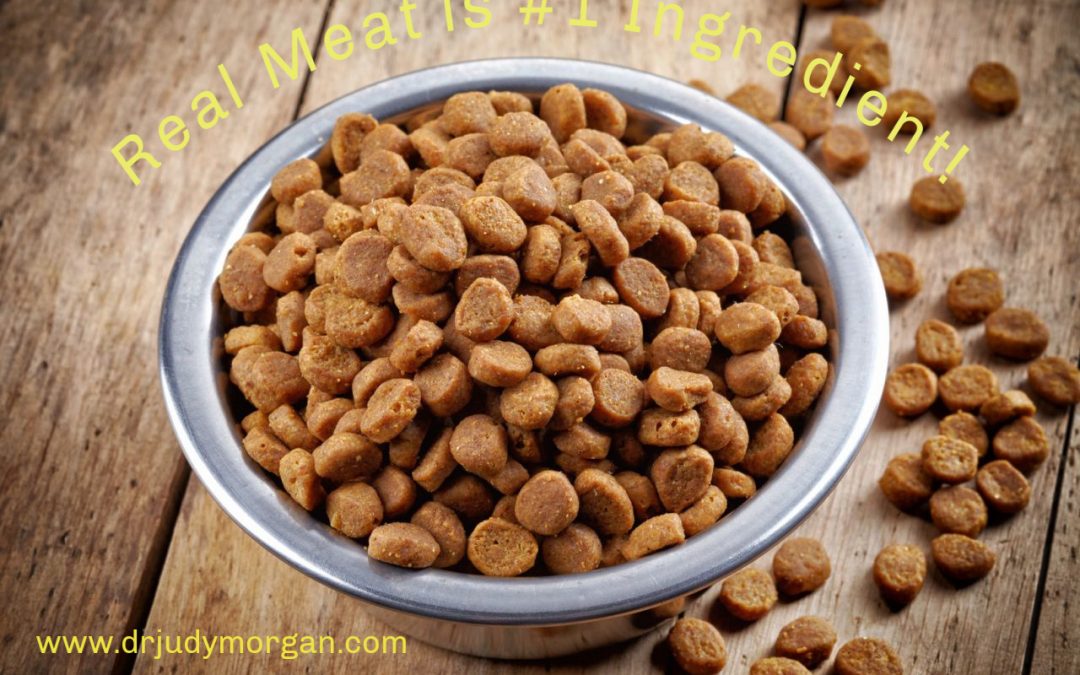Are you well-educated on the meaning of terms used in pet food labeling? The pet food industry, FDA, and AAFCO have come up with definitions that I think are very misleading for the average pet food consumer. By knowing the meaning of these terms, you will be able to see through the gimmicks and choose foods that are truly species-appropriate and healthy for your pets.
Flavor - this may be a chemical or food ingredient added to impart a specific flavor. Animal digest (a rendered product of fats and meat treated with heat, enzymes and/or acids to form concentrated natural flavors, generally not high quality) is commonly used for flavoring. Many treats are labeled "bacon flavor" or "filet mignon flavor" - believe me when I say you won't find real bacon or filet mignon on the ingredient list for these products.
With - This term means there is 3% of the named ingredient in the formulation. For instance, "with chicken" means the percentage of chicken in the formula must equal 3%. Don't be fooled into thinking you are buying a product that has high meat content!
Dinner, Platter, Entree, Recipe, Nuggets, Formula - This product must contain 25% of the named ingredients. A "Chicken Dinner Cat Food" must contain 25% chicken. Notice if it said "Cat Food With Chicken" it would only be 3% chicken. It's up to the consumer to know the difference in the names!! If a whole meat is used instead of a meat meal, the meat ingredient may be only 10% of the ingredient list, as water weight counts as part of the 25%. This is why some people argue that a meat or poultry meal would provide more actual meat in the pet food product than a whole meat source.
- An example from FDA: For example, one pet food may list "meat" as its first ingredient, and "corn" as the second ingredient. The manufacturer doesn't hesitate to point out that its competitor lists "corn" first ("meat meal" is second), suggesting the competitor's product has less animal-source protein than its own. However, meat is very high in moisture (approximately 75% water). On the other hand, water and fat are removed from meat meal, so it is only 10% moisture (what's left is mostly protein and minerals). If we could compare both products on a dry matter basis (mathematically "remove" the water from both ingredients), one could see that the second product had more animal-source protein from meat meal than the first product had from meat, even though the ingredient list suggests otherwise.(Are you confused yet?)
- From the FDA description: In the example “Beef Dinner for Dogs” only one-quarter of the product must be beef, and beef would most likely be the third or fourth ingredient on the ingredient list. Because the primary ingredient is not always the named ingredient, and may in fact be an ingredient that the consumer does not wish to feed, the ingredient list should always be checked before purchase. For example, a cat owner may have learned from his or her finicky feline to avoid buying products with fish in it, because the cat doesn't like fish. However, a "Chicken Formula Cat Food" may not always be the best choice, since some "chicken formulas" may indeed contain fish, and sometimes may contain even more fish than chicken. A quick check of the ingredient list would avert this mistake.
- If more than one ingredient is listed in the name of the food, the two ingredients combined together must equal 25% of the formula. So a "Chicken and Vegetable Dinner" must have a total of 25% chicken and vegetables and each ingredient must make up at least 3% of the formula. That means, chicken might be 13% of the formula and vegetables might make up the other 12% of the formula. The remaining 75% of the formula can be any other ingredients listed on the label ingredient panel. That means you are feeding a VERY LOW meat-ingredient product.
Cat food or Dog food without descriptors - these foods must contain 95% of the named ingredient (excluding water, so only 70%, if using whole meat ingredients). In this instance "Chicken Cat Food" must contain 95% chicken. "Chicken and Liver Cat Food" must contain 95% chicken and liver when added together. Since chicken is listed first in the name, there must be more chicken than liver.
Do you have all this memorized so that you can be an informed consumer? Or are you satisfied with products that say 100% complete and balanced nutrition, no matter what the ingredient list includes? Would you consider feeding this formulation which is marketed as a complete and balanced meal for your dog: Chickpea Flour, Whey Protein Isolate, Oil Blend, Tapioca Solids, Vitamin and Mineral Blend? Personally, I would not.
As our global nutrition challenge becomes more intensified in the next few decades, are we being unrealistic in thinking our pets should only be fed as carnivores? Should we be looking more to grain, legume, and other plant sources for pet nutrition? I'm going to leave this moral dilemma up to the ethicists and philosophers; in the meantime I'm going to continue feeding my pets whole meat diets. And I'm going to continue reading labels, being well-informed as to the real meaning of the terms on the labels.

